Dance your Ph.D.?
Check this out!
http://www.npr.org/templates/story/story.php?storyId=97356050
Near Eastern Art
Most resources I found deal with ancient Near Eastern Art and don’t really bother with present-day, so this covers ancient more than modern. The Near East is a large area, typically defined encompassing the region between the eastern edge of the Mediterranean to present-day Afghanistan lengthwise, and from the Black and Caspian Seas in the north to the southwestern Arabian peninsula widthwise. Some of the world’s most ancient civilizations got their start here, including Sumer, Assyria, Bactria, and Anatolia. The region was rich, with fertile lands and a surplus of natural resources. Surviving art from this time and area comes in the form of pottery, sculptures, carvings, and metalwork. In fact, some of the earliest known examples of metalworking and pottery can be found here. Also noted are their steles, pillars generally wider than they are tall that acted as a sort of tombstone, memorial, or commemoration of an important event. The Metropolitan Museum of Art has an extensive collection of ancient Near Eastern art, featuring fine Sumerian bronzes, ivory carvings, and jewelry from the area/period.



http://www.metmuseum.org/
http://www.asia.si.edu
www.wikipedia.com/stele
Presentation dates
12/11
Public and Private
Impression and Knowledge
Creativity and Replication
12/12
Divide and Assimilate
Form and Content
Iconography and Symbolism
We are meeting at 611 at 10:30 and at the Whitney Musuem at 11:30
Check this link for the cutting edge art forms in the New York Art world
Tool: Lateralus. Form and Content in Progressive Metal
http://www.youtube.com/watch?v=wS7CZIJVxFY
I was first excited to find the video above, then dismayed to find that it said much of what I wanted to say. But by no means all of it, and there is some to correct. But I’m getting ahead of myself.
So there I was, listening to Lateralus for about the thirtieth time, remarking to myself once more how funky Maynard James Keenan’s (the name’s a sobriquet, I imagine it’s a play from his actual name James Herbert Keenan to John Maynard Keynes, the greatest economist of the last century) rhythms were in this song. And so I tapped my fingers across my laptop case, in the familiar sequence.
Black
Then
White are
All I see
In my infancy
Red and yellow then came to be….
WHAAAAAT?????? IS THAT FIBONACCI???? Obviously my first instinct was to panic. How the hell did I miss the Fibonacci sequence? I’m a confirmed pseudomath nerd. I read books about math written for the mathematically mediocre all the time! This’d be like being hit with Fermat’s Last Theorem and not recognizing it. I had to check Wikipedia to confirm my findings (not that I was in any doubt. I just wanted to say what else Tool fans, among the more lyrically and musically sophisticated losers on the interwebs, had contributed to the collective understanding of this song). Here’s what I found:
“ounting between pauses, the syllables in Maynard James Keenan’s vocals during the verses form the first few Fibonacci numbers, ascending and descending:”
“The Fibonacci sequence shares a relationship with spirals, which are mentioned several times later in the lyrics.” (that was actually added this week… it was NOT there when I checked, and I wanted to add it!)
“Additionally, Keenan begins singing at 1:37 into the song. 1 minute 37 seconds, or 97 seconds, is approximately 1.618 of a full minute. This happens to be the golden ratio, which is closely related to the Fibonacci sequence.” (specifically, and I may add this to the wiki-page or at least put in a link to the Golden Ratio/Phi page, the ratio of a step in the sequence to its preceding term approaches Phi [1.618...] as you approach infinity)
“The time signatures of the chorus change from 9/8 to 8/8 to 7/8; as drummer Danny Carey says, “It was originally titled 9-8-7. For the time signatures. Then it turned out that 987 was the 17th step of the Fibonacci sequence. So that was cool.” (I had long since noticed the changes in time signature, but had not been aware of its history or Fibonacci significance.)
“In a 2001 interview, Keenan commented on the lyric mentioning black, white, red and yellow: “I use the archetype stories of North American aboriginals and the themes or colours which appear over and over again in the oral stories handed down through generations. Black, white, red, and yellow play very heavily in aboriginal stories of creation.” (This is a common theme for Tool)
If you guys aren’t impressed yet, then obviously you didn’t watch the video. The fan was obviously a bit on the gushy side, but his interpretation isn’t far off. Tool’s message, “Spiral out. Keep going, going…”, is repeated at the end (I wish I could make something of their decision to make the song exactly 9:24. they rarely do anything without a reason. I just did some quick calculations and could find no relationship to Phi, Pi, e, or any other sexy math). But that’s a very primitive formulation of their message. They say it several ways. The full lyrics are here:
Black then white are all I see in my infancy.
red and yellow then came to be, reaching out to me.
lets me see.
As below, so above and beyond, I imagine
drawn beyond the lines of reason.
Push the envelope. Watch it bend.
Over thinking, over analyzing separates the body from the mind.
Withering my intuition, missing opportunities and I must
Feed my will to feel my moment drawing way outside the lines.
Black then white are all I see in my infancy.
red and yellow then came to be, reaching out to me.
lets me see there is so much more
and beckons me to look through to these infinite possibilities.
As below, so above and beyond, I imagine
drawn outside the lines of reason.
Push the envelope. Watch it bend.
Over thinking, over analyzing separates the body from the mind.
Withering my intuition leaving all these opportunities behind.
Feed my will to feel this moment urging me to cross the line.
Reaching out to embrace the random.
Reaching out to embrace whatever may come.
I embrace my desire to
feel the rhythm, to feel connected
enough to step aside and weep like a widow
to feel inspired, to fathom the power,
to witness the beauty, to bathe in the fountain,
to swing on the spiral
of our divinity and still be a human.
With my feet upon the ground I lose myself
between the sounds and open wide to suck it in,
I feel it move across my skin.
I’m reaching up and reaching out,
I’m reaching for the random or what ever will bewilder me.
And following our will and wind we may just go where no one’s been.
We’ll ride the spiral to the end and may just go where no one’s been.
Spiral out. Keep going, going…
Observe the many references to the form of the song, within its content. “Swing on a spiral”. The song swings on a spiral, because the form of its verse is 1-1-2-3-5-8-13 (fulcrum)-8-5-3-2-1-1 . “urging me to cross this line”, one of several geometric metaphors pertinent to spirals (and Phi, and Fibonacci…). “Reaching out”, which he mentions multiple times, is exactly the act of a spiral, constantly expanding, reaching for new horizons. “Drawn outside the lines of reason”, a statement about their goal: to push their fans (and themselves) to cease thinking linearly and begin thinking laterally (Lateralus… is it coming together yet?). “Push the envelope… watch it bend”, a nice rhetorical flourish, indicating a desire not only to expand the borders of what’s allowed, but to break those rules as well.
An oblique reference to Phi outside the context of spirals comes at the end: “Witness the beauty” may as well have been written with a capital B, because he refers to the Capitalized Essence known as Beauty. Greek mathematicians, whose mystical approach towards numbers has been legendary since Pythagoras, considered Phi the Golden Ratio because of its application in rectangles. An “aesthetically pleasing” rectangle has a ratio of Phi between its long and short side. The amazing thing is that when a square whose side equals the short side is removed from such a rectangle, the result is a similar rectangle, that is, one whose dimensions maintain that golden ratio! “Beauty” and Phi have a historical connection. Similarly, a statement about what “connects us all” may well be a subtle hint to all the literature (much of it, but by no means all, apocryphal) about the Golden Ratio in nature. A classmate pointed out to me this week that the spiral of a nautilus’ shell follows this proportion (I have yet to decide whether or not this information is admissible, as it may have come from “The Da Vinci Code”). The proportion can be found all over our bodies as well (for debunking of extraordinary claims to this effect, though, see http://www.straightdope.com/columns/read/2513/is-phi-a-mystical-number-as-claimed-in-em-the-da-vinci-code-em ).
Does the song (and interpretation of the video artist, who did a decent but not great job) not speak for itself in a form-content discussion? The first instance I know of music built upon the Golden Ratio (though it would not at all surprise me to learn that it was used far earlier… heck, this is right up Bach’s alley), the song actually takes the very idea of spirals to make its point. Break the rules. Grow outward. Do not be bound by linear thinking, think Laterally. Feel the Beauty, the Divine pattern that connects us all (a particularly religious math teacher of mine considers Phi God’s magic number. He also, when asked who discovered Euler’s equation [e^iπ+1=0], replied with a straight face “God”, and proceeded to clarify that it was Leonhard Euler who “wrote it down”).
The content is similar. Black then white, the most primitive of colors, give way to red and yellow, the first primary colors (garnered from Native American creation myths, which in itself is a concept relevant to growth), finally giving way to the power of imagination. Imagination, as Einstein and Maynard James Keenan inform us, is far superior to any overthinking, overanalyzing.
I’d be remiss in my responsibility as a Tool fan not to point out, again, the funky rhythm. The drums are lively and pretty cool, though not as technically impressive as in many of their other songs. Rhythm has always been the musical arena in which Tool has pushed, and bent, the envelope.
Conclusions: Math is cool. Tool are freakin’ smart. A self-respecting metalhead has the attention span to listen to 9 minute songs (though we cannot tolerate top 40 for a duration exceeding 1.618 seconds. It is hardwired into us… God’s magic number, you know). Odd-time signatures are pretty fun to nod your head to. And 2:45 A.M. is the only time to write a progmetal review.
Museum of Natural History- Kate Jackson
Museum of Natural History
Horse Exhibit
This exhibit is devoted solely to (you guessed it) the horse. It starts off with the horse’s beginnings, its ancestors and how it evolved into the horse known today. It makes note of the fact that no true wild horses exist today-the American “wild horse,” or mustang, is really just the descendants of other equines shipped over here, mainly by the Spanish. They’re not truly wild, in other words. The closest modern-day equivalent to wild horses is the Przewalski horse, an Asiatic living fossil. The rest of the beginning of the exhibit is mostly statistics and facts, although they do make interesting mention of zebras. Apparently, zebras are territorial (unlike horses), so they can’t share turnout. They’ll fight. Also, zebras are very aggressive. More zoo handlers are injured by zebras than by tigers, and zebra injuries nearly equal that of all other zoo animal-inflicted as a whole.
Before horses were transportation, they were food. Cave paintings feature the horse more than any other animal. These paintings closely resemble the modern-day Przewalski horse. Apparently they were quite tasty. The exhibit traces the gradual use of horses for transportation, from pulling sledges to being ridden and harnessed to wagons/chariots. Unlike most domesticated animals, the horse’s bone structure didn’t change rapidly after domestication, making it hard for archeologists to tell the difference between wild and tame animals. Horses and other herd animals are easy to domesticate, as they naturally establish a pack hierarchy and will submit to authority, as opposed to lone or pair animals that don’t bend to a lower ranking. Horses can be trained to do many things unnatural to them, like carry riders, pull loads, and jump fences. Training mostly takes cues that horses respond to naturally, and applies them to specific ends. Horses don’t instinctively want to jump over things. In the wild, it’s a good way to break a leg. However, the urge to remain with the herd is much stronger. To teach young horses to jump, first we would lay down ground poles, or cavelettis. It’s not a big deal to walk over them for most young animals. Gradually, the bar is raised. To encourage reluctant horses to cross poles and low fences, a “rabbit” is often used-an older or more experienced horse that the young horse can follow. Techniques similar to this are used to teach young horses to lead, or to follow humans when “leashed.” Foals are walked alongside their dams, with a person walking beside them with a lead. The horse will come to accept the person as a surrogate mother to follow, which is why a small and relatively weak person can lead about a much bigger animal.
Horses were used extensively in warfare. They were used in Japan by the samurai, and in Europe by mounted knights. Samurai were expected to be able to accurately fire their bows from horseback at a gallop, and it has evolved into a sport practiced to this day. Knights often had 3 horses at their disposal: destriers (large horses that carried heavy plate armor) coursers (more agile horses for running battles) and rounceys (placid beasts used for travel). Mongols carried off daring raids from the backs of their hardy ponies, and horses figure into the cowboy and indian myths of America. Even in modern times, US Special Forces will use horses for transportation in terrain unsuitable for vehicles. During World War II, horses were often used in support capacities, pulling ambulance wagons and such. They were fitted with their own special gas masks, which (unlike human masks) left the eyes unprotected.
In many cultures, horses were a sign of wealth. They were sometimes revered as holy, but I’m not sure how people reconciled riding their god about. Until fairly recently in human history, riding was the fastest form of transportation, and helped shape expansion. Horses are also terrific athletes, with many sports focussed around them: dressage, polo, cross country, show jumping, racing, polo, trick riding, rodeo events, barrel racing, pole bending, gymkhana events, and reining. The exhibit featured a looping video of famous riding events, including the Triple Crown, the 2000 Olympics, and the Marshall & Sterling finals. I enjoyed the last, as I know and competed against the girl shown in the video- it was taken from the 2007 Marshall & Sterling finals, and I whipped her soundly in points and at the show.
Riding in all its forms is an inherently dangerous sport, for both riders and horses. Sport Illustrated states that being a jockey on flat races is the most dangerous athletic profession. For horses, with their delicate legs, many sports such as jumping and racing are extremely strenuous. Race track injuries are rampant, as evidenced by Barbaro’s broken leg during one of the past Triple Crown races.

Image of a samurai’s saddle. The stirrups are different than those of most modern saddles in the you don’t put your foot through it. It’s a smart design, as the stirrups used today for most saddles are apt to trap your foot if you fall. A horse once flipped over on me, and my leg became tangled in the stirrups. I was dragged around the ring for a good five minutes before the leathers broke. It may not sound long, but it was an eternity for me at the time.
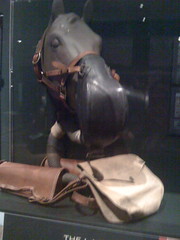
Picture of the gas mask horses were outfitted for during WWII. It was probably motivated less by altruism and more by the fact that a horse going nuts off nerve gas and dying (to leave an unwieldy corpse) would be inconvenient to say the least.
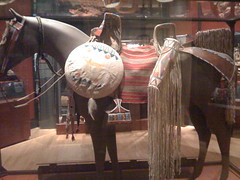
Gear a wealthy Sioux woman would have decked her horse out in. It’s hard to take it seriously, as the way it’s designed would have made it useless for anything other than riding-the girth for the blankets can’t be tightened enough to hold the padding secure, much less save a rider if she attempted to use the ornately beaded stirrups. It’s flashy though.

Heather Jansch driftwood sculpture of a horse. It’s impressive, and life-size. Horses are elegant in form, and make for great art. Much of the gear used for riding is art in for its own sake. Western saddles often feature ornate silver decoration, along with the gear of spanish vaqueros. Bits were designed with elaborate shanks, and the bridle/saddle leather was embossed and worked into beautiful designs. It ties into the discussion of what is art-although these pieces have a clear utility and purpose, great skill undoubtedly went into making them, and they’re beautiful. The photos don’t do justice to the exhibit, but the guards were frowning on photography.

Cave painting, Lascaux Horse, The Granger Collection, New York

Przewalski horse (modern day) [http://library.thinkquest.org/C0114235/geography_PROTECTED_GOBI.htm]
Look familiar?
Drawings By New York- Kate Jackson
The New-York Historical Society
Drawn By New York Exhibit
An exhibit of art by New York artists. Some of the art features scenes from New York, while others depict different views. The New-York Historical Society is a more intimate venue for these paintings, and is entirely less crowded than the other, more popular museums.
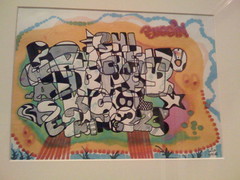

Tracy 182- Graffiti artist, drew inspiration from impressionism, inspired many young artists to pick up the spray can. Images of his “buggin” and “tracy 182″ are done in wildstyle. Originally from the Bronx, he was part of the conception of graffiti. His art is said to resemble the work of German Expressionist Paul Klee, Abstract Expressionist Franz Kline, and Islamic calligraphy. This raises issues on the ethical, emotional, and artists aspects inherent in a bold art that is prominently displayed on other people’s property.



Eve Aschhiem- Strange Water 1999-200, Water III 1996, Water VII 1997- belongs to Aschhiem’s Water Series, a collection of 200 drawings of the Hudson River. Aschhiem obsessively studied water patterns, bringing the Hudson School of American Art into the modern age. Her paintings have no color, yet evoke the sensation and memory of water with the play of light between dark and white, creating unsettled and fluid images. Her work also reflects the words of Heraclitus, in that one cannot step into the same water twice. Aschhiem’s drawings? sketches? paintings? clearly show the wisdom of these words: the water she draws from her studio (repeatedly) never looks the same. There’s something about her images that captures the eye, something undoubtedly liquid despite her monotone color scheme.
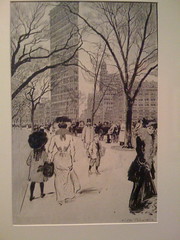
Victor Semon Perard- The Flatiron Building: Fifth Avenue and Madison Square, New York, 1907: coming on the heels of Hassam’s New York and the different between imitation and creation, this black and white sketch of the Flatiron Building caught my eye. Deceptively simple, yet eye-catching, this pen & ink sketch shows a woman from behind, dressed in period fashion, walking towards the uniquely-shaped Flatiron Building in the background. Various other bystanders function in the sketch, but the eye is immediately drawn towards the women, and the building that echoes her upright posture. It is possible that the artist sought to contrast her curves and femininity against the phallic symbol of the building, and if so, he was successful.
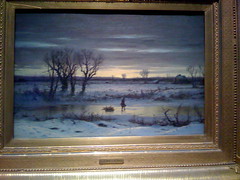
George Henry Boughton: Winter Twilight Near Albany, New York, 1858: icy and desolate, this picture immediately stood out amongst its warmly painted and pastoral fellows. Although pastoral itself in theme, the painting shows a bleak and harsh winter landscape, with scrubby and barren trees, a frozen-over creek, and a little boy dragging firewood along in an overburdened sled. The scene is forbidding; the low-hanging and bruised clouds threaten more snow (undoubtedly why the boy is stocking up on wood). What drew me to this picture is that it doesn’t show the unadorned natural charm of winter, or the rosy picture man would make of it-it shows a single human silhouetted against the dying sun in a dead and frozen waste, and the harsh beauty within it.

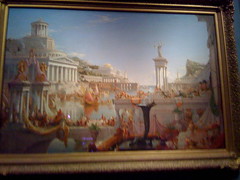
 Thomas Cole: Empire Series: in these three large canvasses, Cole depicts the rise and fall of an Empire. Apparently it was originally created as a cautionary tale for those who would build America into an empire. The first two paintings are a mishmash of great Empires, poorly combined and cluttered despite the skill that went into making them. The last canvas, showing nature’s reclamation and purification of the Empire’s corrupted remains, is striking-the decaying marble edifices, slowly being overgrown with moss and vines, are a warning to how fragile society is, and a cautionary tale for any would-be Caesars.
Thomas Cole: Empire Series: in these three large canvasses, Cole depicts the rise and fall of an Empire. Apparently it was originally created as a cautionary tale for those who would build America into an empire. The first two paintings are a mishmash of great Empires, poorly combined and cluttered despite the skill that went into making them. The last canvas, showing nature’s reclamation and purification of the Empire’s corrupted remains, is striking-the decaying marble edifices, slowly being overgrown with moss and vines, are a warning to how fragile society is, and a cautionary tale for any would-be Caesars.
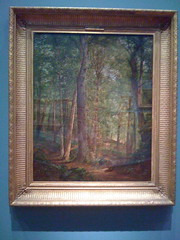
William Trost Richards: June Woods (Germantown), 1864: set in a gallery full of artificially contrived and composed landscapes, the wild, unplanned tangle of Richards’ June Woods is a refreshing and captivating break. Torn between the false landscapes of the Hudson School and critic John Ruskin’s call for absolute artistic fidelity, Richards struck a balance, painting nature, but as he saw it, not as how it was expected to be presented. The scene is a confusion of foliage and undergrowth, riven with winding paths probably made by the hooves of deer. The scene is infused with light and warm, sunlight filtering through the trees above.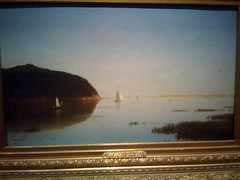
John Frederick Kensett: Shrewsbury River, New Jersey, 1859: a pastoral and planned landscape, this painting shows a panoramic view of the Shrewsbury River. The marshy expanse of water is dotted with the billowing canvas of sailboats, and the only delineation between sky and river is the shore and a frosting of golden reeds across the horizon of the water. Although true to the Hudson School’s depiction of idealized views, this painting isn’t too far from the true, and has a resonance and light to it.
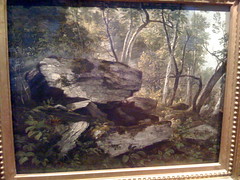
Thomas Hiram Hotchkiss: Catskill Mountains, New York, 1858: this canvas depicts a lifelike outcropping of stone surrounded by saplings and young forest growth. It is a more naturalistic and unplanned depiction of a landscape then typical of the Hudson School artists, which is probably why it’s more interesting-the jumble of rocks and stones create a more intriguing image than that of a staged pastoral scene.
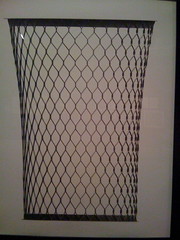
Edward Andrew Zega, Bernd H. Dams: Wire Trash Basket, 2003: Zega and Dams take something as utilitarian as one of the trash baskets common throughout Central Park, and make viewers look at it in a new light. Seen without the distracting back half of the basket, their life-size pen and charcoal drawing pays homage to the unexpected beauty of the ordinary. Their drawing was produced as part of an exhibit celebrating Central Park’s 150th birthday. The baskets themselves are manufactured by Corcraft Products of the New York State Department of Correctional services, a.k.a. New York State’s female inmates. The cans themselves will slowly be replaced. Despite their beauty, they are less than functional and easily crushable. Zega and Dams take a moment to remind New Yorkers to appreciate their trash receptacles before they disappear.
If any of the photos don’t work, they’re also on a Flickr account under katej0530@yahoo.com [http://www.flickr.com/people/32380076@N04/]
Michael Elka - Reviews
About three weeks ago I saw “La Traviata” by Verdi at the Metropolitan Opera. I had seen the opera once before, in Italy, and it was fantastic. This rendition was just as good, and the set design was fabulous. Act One had a particularly great set design, leaving very little of the Parisian salon up to the imagination. Everything was really spectacular, except for something I usually gripe about: the libretto. I grew up speaking Italian with my grandparents, and I know for certain that a great deal of what is said, or sung, rather, in the opera is very colloquial. This colloquial use of the language was not reflected in the translation provided on the monitors; the translation was highly formalized. Opera was originally meant for the elite, but by the time Baroque opera came around, such things as the “opera season” had been introduced in Venice, providing entertainment for everyday people. Personally, I think this was a good thing; it allowed the medium to grow and gain popularity. The excessively formal translations of today, however, take away from that original sentiment of familiarity and universality. Overly poetic translations seem to put opera high up on a pedestal, accessible only to the highly refined. While it is a good thing that performers and composers of opera are revered for the talent, skill, and musicianship involved in producing such work, opera in and of itself should not be held so loftily. A newcomer to opera might read the excessively formal translations of today and be scared away from the genre, and that is sad. While musically and theatrically opera should be held in high esteem, it should still be intimate and familiar, allowing the viewer to actually be comfortable being involved in such a production.
This past Saturday, I saw a production called “Le Sept Plages de la Ruse” (The Seven Boards of Skill) at the Brooklyn Academy of Music. This production consisted of roughly twenty dancers and a large, flat, three-dimensional black wooden box. The box itself was comprised of seven smaller shapes, like triangles and trapezoids. At times, to give an idea of setting, a string instrument was played using pentatonic scales, which give off an Asian vibe and let the viewer know that the work is evocative of China. The dancers used dance, martial arts, and acrobatics throughout the production to move and manipulate the seven pieces of the wooden box, transforming it from its flat state, to one evocative of mountains, plains, cities, etc. At times the dancers would solely be involved in placement of these shapes, while at other times, the shapes would stay stationary and the dancers would “settle” the scene, performing acrobatics. The entire production was evocative of the different landscapes of China and the different cultures that develop because of different geography. For example, when the shapes were flat on the ground, it was clear that the setting was farmland; when sticking in the air, it was clear that the shapes were evoking a mountain range or a city. Each movement of the piece consisted of the dancers “inhabiting” their area, which, again, was symbolized through acrobatics and dance. Each change in scenery, in which the large shapes were moved around, signaled a change in the direction of the production, or a new movement. Overall the production was fantastic, sending a clear message that the people of China, or of any people, both influence and are influenced by their surroundings, in the past, present, and future. I highly recommend it!
Check this out - the future of the opera?
Opera –modern take:
Daniel J. Wakin, “Techno-Alchemy at the Opera”
Shelia Melvin, “Multilayered Story, Multinational Opera”
Dave Izkoff, “Opera With Heart (Also Spleen, Liver and Entrails)”
A chance to view Private collections of Oceanic Art
Dear Class,
Those of you who are interested in the commercial value of art and the auction house, please join me first for a short tour of the exhibit of the Rosenthal collection of African and Oceanic Art at Sotheby and then come to the auction itself.
The artifacts are on display from 12:00 PM to 5:00 PM at the gallery today, tomorrow and Thursday, and the auction takes place Friday at 2:00PM. I will be happy to take a few of you with me after class or a little later on Thursday. The objects will not be on display the day of the Auction.
http://www.sothebys.com/images/home/flash/rosenthal2008/index.html


